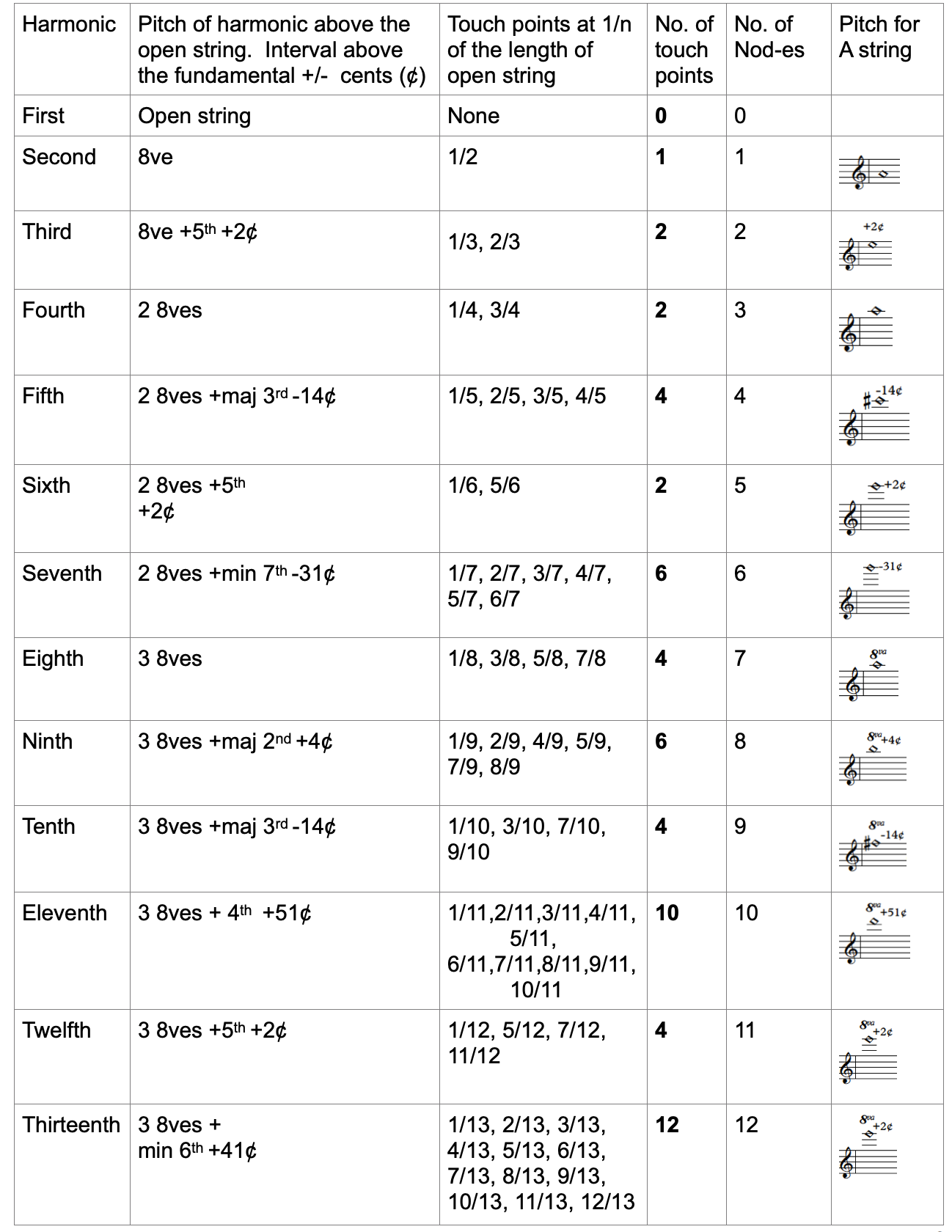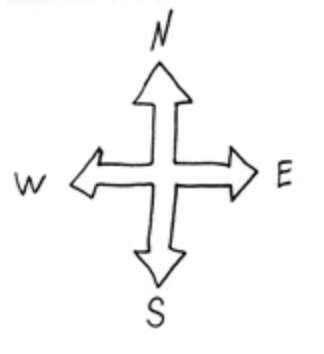*For a simple and efficient tool to help you find harmonics and multiphonics, download the new CELLO MAP APP
The set of touch points for a harmonic is a subset of the harmonic’s nodes. For some harmonics, every node is also a touch point, and for others there are fewer touch points than nodes. It is useful for a cellist to know all of the alternative touch points for a particular harmonic, to be able to find an efficient and flexible fingering.
The set of nodes for all harmonics is ‘n-1’, where n is the harmonic order (i.e., there is 1 node for the second harmonic, 2 nodes for the third harmonic, etc.). So, the maximum number of touch points for a harmonic is n-1. All prime number order harmonics have the maximum, n-1 touch points. For example, the second harmonic has one touch point, at ½ of its length and the third harmonic has two, at 1/3 and 2/3 of its length, the fifth has four at 1/5, 2/5, 3/5 and 4/5, etc. The number of touch points of non-prime number harmonics is restricted by another factor: a node is excluded from the set of touch points for a particular harmonic if it coincides with the node of a lower harmonic.
For example, the fourth harmonic is produced when the string is touched at 1/4 of its length or at 3/4 of its length, however not at 2/4 (=1/2) of its length: in this case the second harmonic is produced.

Similarly, for the sixth harmonic: the sixth harmonic has nodes at 1/6, 2/6, 3/6, 4/6 and 5/6 of the string. However, touch points only occur at 1/6 and 5/6 of the length of string since 2/6 (=1/3) and 4/6 (=2/3) are touch points for the third harmonic and 3/6 (=1/2) is a touch point for the second harmonic. In other words, a cellist does not have many options to find alternative fingerings for the sixth harmonic.

Arranging this information in a table for the first sixteen harmonics shows how the number of touch points fluctuates.

The pitches shown in the right-hand collumn are approximate. Tuning deviations occur because of string stiffness. These deviations are increased for higher harmonics, and on thicker strings.
The pattern of available touch points is always symmetrical about the middle of the string. Describing the above table of possible touch points in pictorial terms demonstrates this.

▶︎AN ALGORITHM FOR FINDING TOUCH POINTS
The easiest way to find the position of touch points for a particular harmonic is by drawing a diagram similar to B2d or by following a simple algorithm:
- 1, List the nodes as fractions: 1/n, 2/n…a/n…(n-1)/n
- 2, Remove fractions that can be simplified i.e. 2/(n= 2b), 3/(n=3b)…
The result is the list of touch points in the form a/n. The position of each touch point is the ath node from the nut. For example
The nodes for the 12th harmonic are:
1/12, 2/12, 3/12, 4/12, 5/12, 6/12, 7/12, 8/12, 9/12, 10/12, 11/12
The following fractions in which can be simplified:
2/12, 3/12, 4/12, 6/12, 8/12, 9/12, 10/12,
Leaving the touch points:
1/12, 5/12, 7/12, 11/12
That is the first, fifth, seventh and eleventh nodes from the nut.
The simplest way to find the position of the harmonic nodes relative to stopped string pitch (see figure B2e) is to start with the node closest to the bridge. This node, always a touch point, is equal to the pitch of the harmonic. By calculating the harmonic series backwards from this touch point, the position of each node can be calculated. The node immediately below this is an octave lower, the subsequent nodal position is an octave and a fifth minus 2 cents higher, the subsequent nodal position is two octaves higher, etc. The deviation in cents of the natural harmonic series must be taken into account. For example:
As above, touch points for a particular harmonic x are written in the form n.x, where x=1 is the touch point closest to the nut and x=n-1 is the touch point closest to the bridge. Nodes of a harmonic that are included in the touch points of a lower harmonic are written in the form n.(x).
The pitch of touch point closest to the bridge for the tenth harmonic, 10.9, is C#7-14¢. The pitch of the nodal point immediately below this, 10.(8), is 10.9 – one 8ve = C#6-14¢.
Similarly 10.7 = 10.9 – (8ve +5th +2¢) = C#7-14¢ – (8ve +5th +2¢) = F#5-16¢
10.(6) = 10.9 – (2 8ves) = C#7-14¢ – (2 8ves) = C#5-14¢
10.(5) = C#7-14¢ – (2 8ves +maj 3rd -14¢) = A4
10.(4) = C#7-14¢ – (2 8ves +5th+2¢) = F#4-16¢
10.3 = C#7-14¢ – (2 8ves +min 7th -31¢) = D#4+17¢
10.(2) = C#7-14¢ – (3 8ves) = C#4-14¢
10.1 = C#7-14¢ – (3 8ves +maj 2nd +4¢) = B4-18¢
To double check the result of the above algorithm, the number of touch points for any harmonic can be quickly calculated using the following formula. As explained above, nodes are excluded from the set of touch points if they are already touch points for another harmonic – that is, if the harmonic order has integer factors. All prime number order harmonics, therefore, have the maximum number of touch points, n-1 where n is harmonic order. The number of touch points for non-prime harmonics is n-1 minus the touch points for each prime factor of n. This can be summarised for primes and non-primes as:
Π [fa-fa-1] a≥0
Where f is a prime factor of the harmonic order, n and a is the highest factor of the prime.
For example the sixth harmonic has two prime factors, 2 and 3, its factorisation is 2×3 therefore the number of touch points is:
(21-20) x (31-30) = 1×2= 2
The twelfth harmonic has two prime factors, 2 and 3. Its factorisation is 2x2x3
The number of touch points is:
(22-21) x (31-30) = 2×2= 4
The seventh harmonic has no factors apart from itself since seven is a prime number. The number of touch points is:
(71-70) = 7-1 = 6
Thanks to Prof. Erik Oña for devising this formula.


